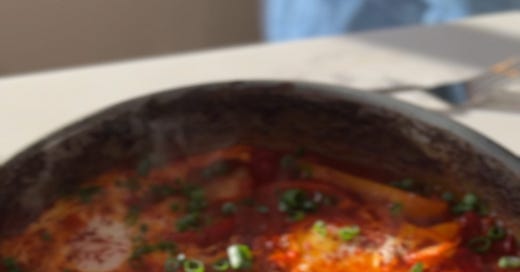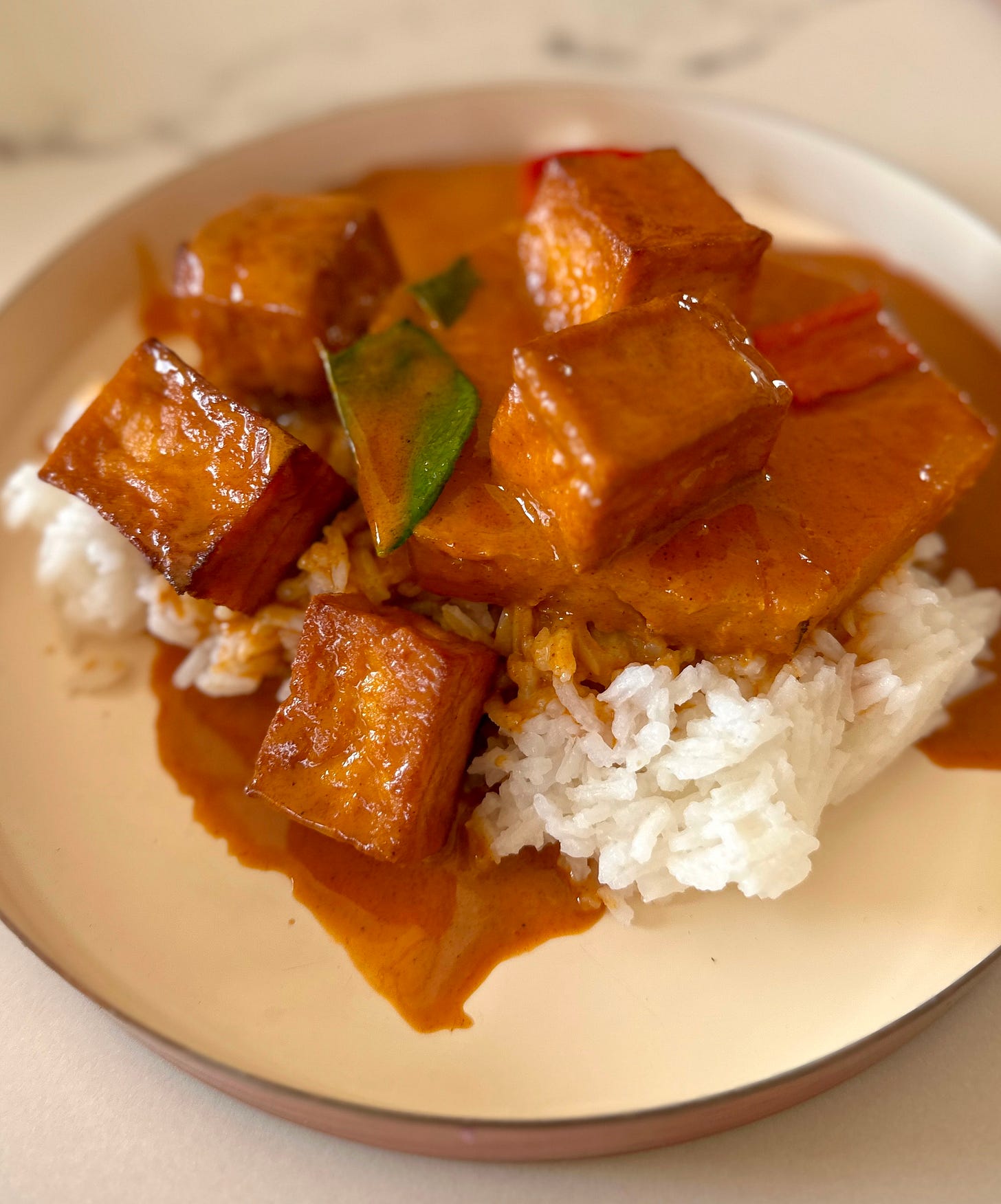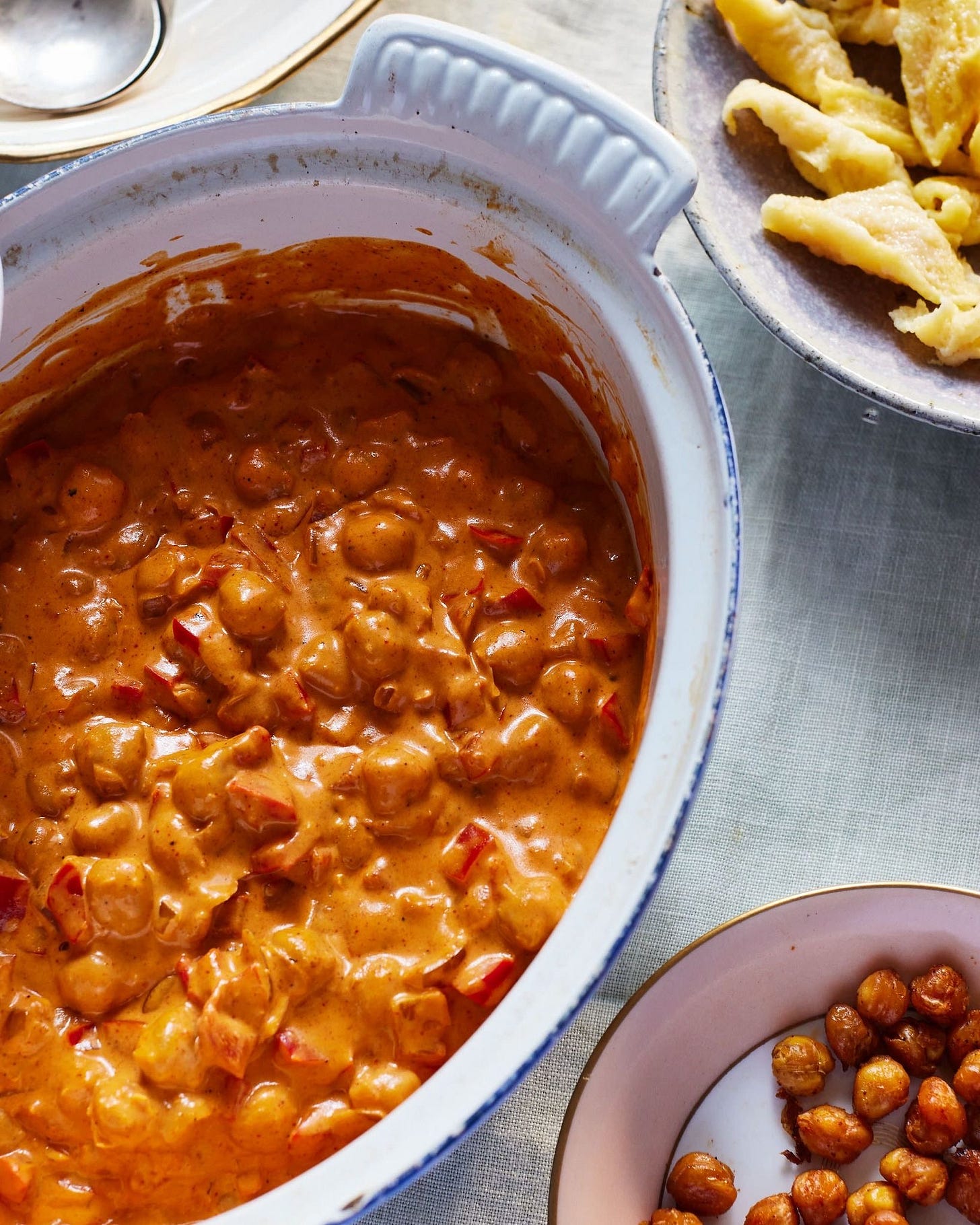Real Women Write Great Cookbooks
Two new ones to check out (with a recipe from each), plus an original recipe for kimchi shakshuka from yours, truly.
Real women write great cookbooks, and this week I’m featuring two recently released by women I admire. These weren’t privileged “nepo babies” of the food world, or any world. In fact, they each created their own success through sheer inspiration and determination. Though they both live in the United States now, they are both immigrants (yes, immigration is a good thing!) who bring a unique perspective to their work and cooking. Neither grew up privileged or connected; they both worked and studied in other disciplines, found their true callings, and landed where they were always meant to be. And I have to say, we’re all the better for it.
First, Nok Suntaranon and Kalaya’s Southern Thai Kitchen Cookbook.
I’m not going to lie, I’ve been way down in the cooking dumps lately. Mini-reveal: I’ve been working on a giant new project (hint: it’s got close to 100 recipes and has a hard cover) and in spite of the turmoil around me, there have been full months where the inspiration has flowed surprisingly freely, like fresh rainwater downstream.
Spices, flavors, seasonal produce, and local cultural influences meet in my mind in beautiful ways that effortlessly translate into food that has taste, spirit, and meaning. In the midst of what has undoubtedly been the hardest year I ever experienced, I am grateful for those times, for those hours when I escape into the kitchen, not scanning the news, not absorbing tragedy, not running into our safe room or thinking about hostages, armies (so many people here are soldiers, know soldiers, or are related to soldiers), terrorist organizations, or innocent children across the border powerless amid forces far greater than them.
But then there are months like this one, ones where everything tastes the same in my mind, in the skillet, and on the plate.
Then, a couple of months ago, I got a message from Nok Suntaranon, the owner of the amazing Kalaya restaurant in Philadelphia. I don’t know Nok well, though I feel like I do. Last September she came with a group of friends to the dinner Mike Solomonov threw at Zahav to celebrate the release of my Shabbat Cookbook. She was warm, charismatic, and complimentary (what’s not to like?).
A few months later she was named Best Midatlantic Chef by the James Beard Foundation. And then she reached out to say a close friend was coming to Israel. She could send an early copy of her cookbook, Kalaya’s Southern Thai Kitchen, and did I want a copy?
Did I want a copy. Ha.
If you’ve seen photos or videos or my apartment, I always want a copy. I’ve been reading cookbooks like novels since I was a teenager, and the delicate calculus of how much room I can make for new additions is a weekly consideration (when I moved to Israel, I donated hundreds of cookbooks to the New York Public Library). But this was one I couldn’t refuse, and I am so glad I didn’t.
I am often asked about what makes a great cookbook, and at the beginning of my own journey I wasn’t quite sure how to answer. But nearly 15 years and 17 books later, I think I know. A good cookbook is a novel. There’s a premise to be explored. A plot. A real story arc. Drama. Suspense. And a sense of resolution. The best books–and cookbooks–have all of these elements, and Nok’s book delivers. It begins with the story of her childhood in Southern Thailand, a proud and modest childhood with an incredible mother–Kalaya–who with little means produced magnificent food every day, eventually opening a popular curry paste stall where young Nok, at age 4, began assisting mother. Spices and cooking were her life from childhood, and even though she eventually became a successful flight attendant, at the same time she was running a popular Italian restaurant in Bangkok. Eventually she fell in love, moved to Philadelphia, attended culinary school, and opened Kalaya in 2019, dedicating the restaurant to her mother. The restaurant was an out-of-the-gate success, though as we know, instant success is years in the making. In the book Nok writes about how it took her years to figure out how to adjust her recipes to what was available in the United States without compromising. And so she did.
Reading about her upbringing in a lesser-known province in Southern Thailand–the markets, the aromas, memories, and foods that shaped her identity–I felt my taste buds revived, my keyboard beckoning, my skillets calling me back behind the hob. Nok’s story literally willed me backinto the kitchen, where I made her alluring red curry paste, fragrant with galangal and lemongrass and a building block of her kitchen the way schug or harissa are fundamentals of mine.
I related to her process, and the way that curry paste can hang out in the fridge, waiting to be used in dishes like this Gaeng Pajari, a dish of seared tofu with pineapple coconut curry.
Thank you, Nok, to you and your book and your beloved Kalaya, for bringing me and my kitchen back to life. (Note: Cookbook is not kosher. Adapt to your liking! The recipe I include here is kosher).
Gaeng Pajari (Seared Tofu & Pineapple Coconut Curry)
This is a surprising recipe. The pineapple, braised in the rich coconut curry, becomes almost as meaty as the crispy tofu you add in later.
4 tablespoons canola oil
1 tablespoon paprika
½ cup Red Curry Paste (recipe follows)
1 tablespoon white miso
3 1/2 cups canned coconut milk
½ ripe pineapple, peeled (but not cored) and cut into 6 thick rounds
1 cinnamon stick
1 star anise pod
a (1-pound) package extra-firm tofu
1 tablespoon soy sauce
3 red long hot chilies. halved lengthwise, seeded, and cut into 2-inch pieces
4 or 5 makrut lime leaves, torn
In a wide, deep skillet or pot, heat 2 tablespoons of the oil over medium heat. Add the paprika and stir until it is fragrant; then add the curry paste and miso. Cook, stirring, until you can really smell the spices in the curry paste. Then stir in 1 cup of the coconut milk, the cinnamon stick and the star anise pod and increase the heat to high.
When the sauce begins to bubble, add the pineapple slices, arranging them in a single layer (it's fine if they overlap a little), then pour 2 cups of the coconut milk over top. This should fully submerge the pineapple slices; if it doesn't, pour in just enough water to submerge them (you shouldn't need much more than ½ cup). Reduce the heat to low and simmer until the pineapple cores are fork-tender and the oil has separated on the top of the sauce, 45 minutes to 1 hour, flipping the pineapple once halfway through.
When the pineapple has about 20 minutes left to cook, cut the tofu into 12 equal pieces (I like cubes, but you can do anything you want). Pat all the pieces dry with paper towels.
In large nonstick skillet, heat the remaining 2 tablespoons oil over high heat until just starting to smoke. Add the tofu in a single layer, reduce the heat to medium, and sear the tofu until it is golden brown on every side, about 10 minutes total. Put the seared tofu on a plate.
When the pineapple is finished cooking, add the soy sauce and tofu and stir gently to combine.
Add the chilies and cook for a minute or two, until they soften a bit. Then add the lime leaves and cook for 1 or 2 more minutes, until fragrant. Finish with the remaining ¼ cup coconut milk, stirring it gently into the sauce.
Transfer the pineapple slices to a platter, top them with the tofu, and pour the sauce over top. Serve with jasmine rice.
Gaeng Dang (Red curry paste)
Makes 3 cups
This curry paste is milder than I imagined, perfect for many red curries. It lasts for a long time in the fridge and is great as the base for the pineapple tofu curry.
½ cup sweet paprika
½ cup red chili flakes
½ cup packed minced fresh lemongrass, tender white parts only (about 3 stalks)
10 large garlic cloves, roughly chopped (about ½ cup)
3 large shallots, sliced (about 2/3 cup)
3 tablespoons finely chopped peeled galangal, fresh or thawed if frozen
5 makrut lime leaves, thinly sliced (1 packed tablespoon)
1½ cups roughly chopped fresh cilantro roots and/or stems
3 tablespoons freshly ground black pepper
1 tablespoon ground white pepper
1½ to 2 tablespoons kosher salt
1½ cups water
In a blender or food processor, combine the paprika, chili flakes, lemongrass, garlic, shallots, galangal, lime leaves, cilantro roots, black pepper, white pepper, salt, and water, and stir to distribute everything evenly, then process until smooth. You can store it in the fridge for up to 1 week, then freeze any leftover paste in a zip-top bag or other airtight container for up to 3 months.
Pass the Plate by Carolina Gelen
Last month saw the release of
’s cookbook, Pass The Plate, and I was so thrilled to receive a copy (Thank you, Carolina!). If you haven’t heard of Carolina, then you probably haven’t been on Instagram much since the pandemic broke out because Carolina broke out, too. Her videos–like an upside-down orange semolina cake, or butter beans a la vodka-- began going viral, amassing millions of followers on social media.Born of modest means in post-Communist Transylvania–yes, it’s real place, part of Romania!–she learned English by watching food television and studied computers, but the autodidact in her drove her to become highly skilled in both cooking and filming/editing at just the right time. She writes that she recorded her first videos in her tiny living room, often with her mother holding props or light deflectors. I think one of the reasons her content is so popular is because she has an aw-shucks quality to her, a quietness amidst all of the noise of the internet, that actually makes her stand out. She’s a talented, funny, wise-beyond-her-years cook whose recipes are exciting, not intimidating. She’s someone you’re genuinely happy to be happy for!
She managed to find her way to the United States in 2021 and lives in Utah, where she is maddeningly prolific. While posting practically a recipe a day she also managed to write Pass The Plate, which became a New York Times best seller upon its release. It’s filled with smart, easy recipes like the one for chickpea paprikash she shares with you here. For those of you who keep kosher and wanted to try paprikash–a creamy, paprika-laced Hungarian stew usually made with meat–this is your chance.
Paprikash-Inspired Chickpea Stew with Dumplings
Serves 4 to 6
Prep Time: 25 minutes
Cook Time: 55 minutes
Total Time: 1 hour 20 minutes
Crispy Chickpea Topping:
2 (15-ounce) cans chickpeas, drained and rinsed
2 tablespoons extra-virgin olive oil or sunflower oil
2 teaspoons sweet paprika
Kosher salt
Creamy Chickpea Paprikash:
¼ cup extra-virgin olive oil or aunflower oil
I medium yellow onion, finely chopped
2 large red bell peppers, finely chopped
Kosher salt
5 garlic cloves, finely chopped or grated
3 tablespoons sweet paprika
1 heaping tablespoon tomato paste
½ teaspoon cayenne pepper, plus more to faste
2 (15-ounce) cans chickpeas, drained and rinsed
1½ cups heavy cream or 1 (14-ounce) can full-fat coconut milk
1 tablespoon cornstarch
Make the crispy chickpea topping:
Preheat the oven to 425°F. Line a baking sheet with parchment paper.
Add the chickpeas to the baking sheet and roll a kitchen or paper towel over them to remove excess moisture. Drizzle the olive oil on top and add the paprika and a pinch of salt. Toss to coat.
Roast until the chickpeas are crunchy and golden, about 20 minutes.
Meanwhile, make the creamy chickpea paprikash:
In a large Dutch oven or saucepan, heat the olive oil over medium heat. Add the onion and cook, stirring frequently, until softened and golden, 8 to 9 minutes. Add the bell peppers and a pinch of salt and cook, stirring occasionally, until softened, about 10 minutes. Add the garlic, paprika, tomato paste, and cayenne and cook, stirring constantly, until the tomato paste has darkened and the spices and garlic are fragrant, about 2 minutes.
Add the chickpeas and toss to coat in the spices, adding a splash of water and stirring to break up the browned bits at the bottom of the pan. Cook to let the chickpeas warm through and absorb some of the flavors, about 3 minutes. Stir in the cream, a hefty pinch of salt, and 1½ cups water and bring to a simmer. Reduce the heat to medium-low and simmer, stirring occasionally, until the chickpeas are soft and flavorful, 25 to 30 minutes.
In a small bowl, whisk the cornstarch with 2 tablespoons water. Add the cornstarch slurry to the soup and continue simmering, stirring constantly, until thickened, 4 to 5 minutes. Crush some of the chickpeas against the side of the pot with the back of and cover to keep warm. the spoon. Remove the pan from the heat and cover to keep warm.
Kimchi Shakshuka
Reading these two great cookbooks which both talk about using what you have on hand and being economical with ingredients—that it doesn’t have to be fancy to be fantastic—really inspired me. I came up with this as a way to use up leftover kimchi, and it works so, so well. In recent years shakshuka–a Tunisian breakfast dish of tomatoey sauce and runny eggs–has lent itself to any number of adaptations. The funky tang of kimchi works well, bringing acidity to the sauce. If you don’t have kimchi, chopped Moroccan-style pickles (there’s a recipe in Sababa) would also work really nicely here!
¼ cup extra-virgin olive oil, plus more for drizzling
Kosher salt and freshly ground black pepper to taste
1 medium onion, finely diced
1 large red bell pepper, seeded and chopped
1 large yellow or orange bell pepper, seeded and chopped
3 large garlic cloves, thinly sliced
1 teaspoon gochugaru or other mild hot chili flakes
2 1/2 pounds very ripe fresh tomatoes, chopped (6 cups) shakshuka
1/2 cup kimchi, chopped
2 tablespoons gochujuang
6 eggs
Sliced scallion greens, for garnish
Pita or other bread, for serving
Set a rack in the top third of the oven. Heat the olive oil in a large oven-safe skillet over medium-high heat. Add the onion and cook, stirring, until the onion is lightly golden and softened but not too dark, 8 to 9 minutes. Add the garlic and bell peppers and until the peppers soften, 5 minutes. Add the tomatoes, kimchi, gochujuang, and gochujaru. Bring to a boil, then reduce the heat to a simmer and cook until the sauce has darkened and thickened slightly, 20 to 25 minutes; season with additional salt and black pepper to taste.
Preheat the broiler during the last 5 minutes of cooking. Use a spoon to form 6 wells in the sauce, crack an egg into each well and cook for 3 minutes. Transfer the shakshuka to the oven and broil until the top of the sauce is slightly caramelized and the whites of the eggs are just opaque but the yolks are still runny, 2 to 3 minutes. Remove from the oven (use an oven mitt since the handle will be hot), top with fresh gochugaru, garnish with scallions, and serve immediately, or cool to room temperature and serve, sandwich-style, stuffed into pitas or piled on top of bread.







The recipes look wonderful. This year + is zapping all the colors and tastes from life, but we owe it to ourselves and our loved ones (and the hostages and soldiers) to do everything possible to stay determined and positive about the future. Hang in there, Adeena.